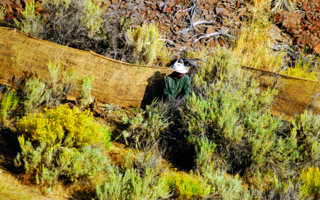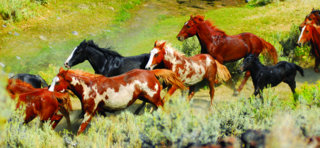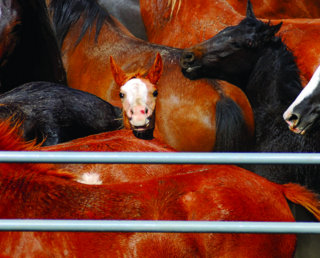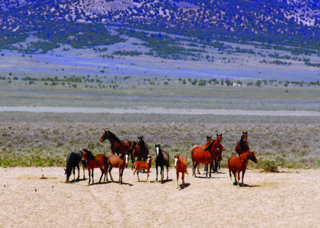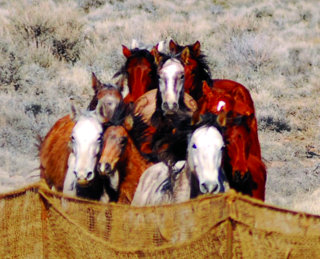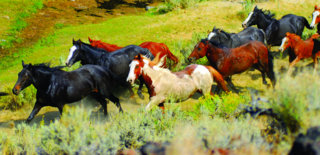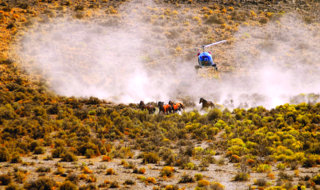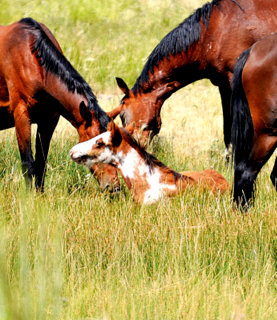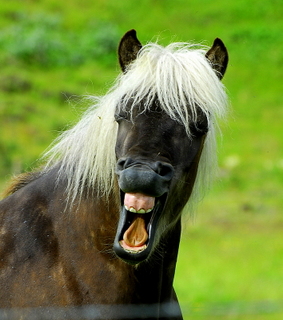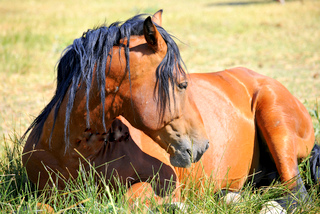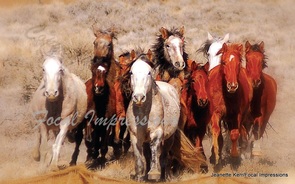
Mustangs were introduced to the Nevada region by the Spanish conquistadors in the early sixteenth century. The name mustang is derived from the Spanish word mestengo, meaning wild or stray animal. Almost five centuries ago, in 1519, General Cortez documented the brilliant colours of his expedition's horses, and many of these colours still appear in the wild mustangs of today. Through the years, these horses of Spanish descent flourished and informed the variety of the breeds we see today.
However, about 55 million years prior to their reintroduction to the south western region of the United States, these horses' ancestors had originally inhabited the continent. Over time, these indigenous horses became extinct, and remained so for almost fifteen thousand years. Why they disappeared remains a mystery. Similarly, just how the mustang came to re-inhabit the deserts and the Great Plains of North America is a topic of ongoing debated. It was long believed that the pre-extinction American horse has not the primitive configuration of the true horse of today. However, that theory changed.
In 1993, near Dawson City, Yukon Territory, Canada, two local placer miners, Lee Olynyk and Ron Towes, uncovered a horse in the permafrost. Its flaxen mane was entangled around its neck and hide. It looked exactly like the modern-day horse. Paleontologists studied the brownish-red horse and dated it as being 26,000 years old. The species died out about 10,000 years ago.
However, about 55 million years prior to their reintroduction to the south western region of the United States, these horses' ancestors had originally inhabited the continent. Over time, these indigenous horses became extinct, and remained so for almost fifteen thousand years. Why they disappeared remains a mystery. Similarly, just how the mustang came to re-inhabit the deserts and the Great Plains of North America is a topic of ongoing debated. It was long believed that the pre-extinction American horse has not the primitive configuration of the true horse of today. However, that theory changed.
In 1993, near Dawson City, Yukon Territory, Canada, two local placer miners, Lee Olynyk and Ron Towes, uncovered a horse in the permafrost. Its flaxen mane was entangled around its neck and hide. It looked exactly like the modern-day horse. Paleontologists studied the brownish-red horse and dated it as being 26,000 years old. The species died out about 10,000 years ago.
The History of Mustangs In Nevada

DID YOU KNOW?
Since 1973 the Nevada Bureau of Land Management has gathered nearly 200,000 wild horses and burros and placed them in adoptive homes. The current population consists of approximately 20,000 wild horses and 1300 burros.
Most wild horses and burros gathered in Nevada are transported to Palomino Valley, a wild horse placement centre north Reno, Nevada. Each animal is fed, identified and vaccinated. Once this process is completed, they are classified fit for adoption.
Foals are born with legs 90% of their full adult length.
Breeding a male donkey with a female horse results in a mule.
Breeding a female donkey with a male horse results in a hinny, a donkey mare is called a jenny.
When faced with danger some stallions will grab a foal by the neck and run with it in its mouth to safer ground. (We witnessed this event in a small herd of horses very near the Santa Fe Mine.)
When stallions encounter and intruding male, in lieu of fighting, most times they will have a squealing contest.
The Kiger horse was used as a model for the animated film `The Spirit Stallion of Cimmeron`.
Horses sleep an average of 2-3 hours a day. Only 45 minutes of this is spent lying down.
Horses cannot breathe through their mouth.
Combings from the Bashkir horse coat can be woven into warm blankets and clothing.
Nevada means snowy in Spanish.
The Nevada state flower is the Sagebrush.
There are over 150 breeds of horses.
The gestation period for pregnant mares is 11-12 months.
The movie `The Misfits` starring Clark Gable and Marilyn Monroe was shot in Dayton and Reno Nevada in 1961. It featured the wild mustangs of the area.
Since 1973 the Nevada Bureau of Land Management has gathered nearly 200,000 wild horses and burros and placed them in adoptive homes. The current population consists of approximately 20,000 wild horses and 1300 burros.
Most wild horses and burros gathered in Nevada are transported to Palomino Valley, a wild horse placement centre north Reno, Nevada. Each animal is fed, identified and vaccinated. Once this process is completed, they are classified fit for adoption.
Foals are born with legs 90% of their full adult length.
Breeding a male donkey with a female horse results in a mule.
Breeding a female donkey with a male horse results in a hinny, a donkey mare is called a jenny.
When faced with danger some stallions will grab a foal by the neck and run with it in its mouth to safer ground. (We witnessed this event in a small herd of horses very near the Santa Fe Mine.)
When stallions encounter and intruding male, in lieu of fighting, most times they will have a squealing contest.
The Kiger horse was used as a model for the animated film `The Spirit Stallion of Cimmeron`.
Horses sleep an average of 2-3 hours a day. Only 45 minutes of this is spent lying down.
Horses cannot breathe through their mouth.
Combings from the Bashkir horse coat can be woven into warm blankets and clothing.
Nevada means snowy in Spanish.
The Nevada state flower is the Sagebrush.
There are over 150 breeds of horses.
The gestation period for pregnant mares is 11-12 months.
The movie `The Misfits` starring Clark Gable and Marilyn Monroe was shot in Dayton and Reno Nevada in 1961. It featured the wild mustangs of the area.
